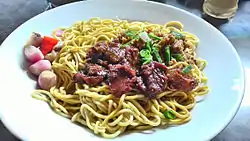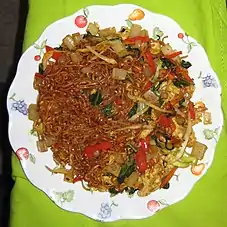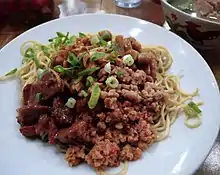Bakmi
Bakmi consists of two Hokkien Chinese words literally translated to English as "meat noodles" (肉麵, Pe̍h-ōe-jī: bah-mī). Bakmi is a wheat based noodle which was brought to Indonesian archipelago by Hokkien Chinese immigrants from Fujian, generally prepared and topped with minced pork seasoned in soy sauce and A few slices of char siu (叉燒) or barbecued pork, with addition of Chinese green vegetables and a bowl of broth.
 Bakmi topped with pork | |
| Type | Noodle |
|---|---|
| Place of origin | Indonesia[1] |
| Region or state | Southeast Asia |
| Main ingredients | Wheat flour, ground pork, soy sauce |

Today, bakmi has become one of the most common noodle dishes, especially in Southeast Asia which has significant Chinese populations. The dish has also been further developed to more closely align with the local tastes. Bakmi is between Chinese style wheat noodles and Japanese udons in thickness, and there are several variants of bakmi in Indonesia. Although the name bakmi literally translate to "pork noodle", different types of meat might be used, including chicken and beef. Variation includes mie ayam (chicken noodle) and mie goreng (stir fried noodle in sweet soy sauce).
Origin and history
Chinese influences is evident in Indonesian food, such as bakmi, mie ayam, pangsit, mie goreng, and kwetiau goreng.[2] The dish is derived from Chinese cooking tradition. Bakmi/bami strongly resembles the Chinese noodles called lamian and mee pok. While Bakmi noodles are made from wheat (and in cooked form are also used as Spaghetti), the Chow Mi or Chow Mein noodles are made from rice flour. It is said that Marco Polo introduced the Bakmi noodles in Italy which became Spaghetti. In Thailand, wheat noodles are also known as bami (Thai: บะหมี่). It is eaten mainly in noodle soups and in Chinese style stir-fried noodle dishes.
The words mie and bami, used in Dutch, come from bakmi and were introduced into the Dutch language during the Dutch colonial period in Indonesia. Indonesian food is very popular in the Netherlands, and bami goreng (fried bakmi) is a popular dish.
Ingredients
Bakmi is a type of wheat noodle with a slightly pale yellow colour. The most common type of bakmi in Indonesia is mi kuning, or 'yellow noodles' made from finely ground wheat, sometimes enriched with eggs as mi telur (egg noodle) made into dough, ground and run through holes to create noodle strings. The traditional way to create bakmi is by pulling the dough several times coated with flour to create the noodle strings, similar to the method to make lamian.
The most common recipe of bakmi dish in Indonesia uses chicken meat as the majority of Indonesians are Muslims. Chicken noodle (Indonesian: bakmie ayam or mie ayam), mie ayam is wheat noodle topped with diced chicken meat seasoned in soy sauce. Mie ayam often accompanied with wonton (Indonesian: pangsit) either crispy fried or in soup, and also bakso (meatball). Bakmi ayam is a popular Chinese Indonesian dish and ubiquitous in Indonesian cities, it can be served in a restaurant to a humble travelling cart. The other popular Indonesian bakmi recipe is fried bakmi (Indonesian: bakmie goreng or mie goreng).
Preparation
Bakmi is normally boiled for serving. When bakmi is intended for use in soup, it is usually boiled separately from the broth. The noodles are usually mixed with either pork fat, chicken fat or beef fat. They are then served with toppings that vary from the most common, diced seasoned chicken with choy sum and fried wonton skin, to more expensive type using fried or boiled wonton and bakso (meatballs). The soup is served in a different bowl, and is added to the noodles by the individual diner according to taste.
Some boiled bakmi are also served with thick gravy instead of a soup, or stir fried. The stir fried process follows after boiling the bakmi, it is stir-fried with vegetables, sweet soy sauce, meat, eggs or any other ingredients such as curry powder or gravy. However, there are exceptions such as i fu mie, which is bakmi that is first deep fried and then topped with vegetables, meat, and gravy.
Varieties
Indonesian

- Bakmi Bangka, a Chinese Indonesian noodle dish from Bangka island. It is a plate of noodle topped with minced pork, slices of braised pork, mushroom and chopped scallion.[3] The original Chinese Indonesian version uses minced pork, the halal version however, usually uses minced chicken.[4]
- Bakmi Siantar, pork noodle from Pematang Siantar town in North Sumatra, usually served with red char siu coloured with angkak. Popular within Batak cuisine, it was derived from, and possibly the most closer version to the traditional Chinese Indonesian bakmi (meat/pork noodle).[5]
- Bakmi ayam or Mie ayam, Indonesian Chinese chicken noodles.
- Bakmi goreng, Indonesian Chinese fried noodles, omnipresent in Indonesia
- Bakmi Jawa, from Central/East Java with somewhat wet consistency
- Bakmi Aceh, from Aceh, it has a curry-like flavor
- Bakmi Celor, from Palembang, it has a sweet starchy gravy.
- Mie Pangsit or Wonton Mi, generally known from Sumatera area, North Sumatera, Medan, etc.
- Bakmi Belitung, from Belitung island, with sweet white sauce.
- Bakmi kangkung, it is composed of noodles, kangkung, bean sprouts, lime juice, mince meat, and broth.
Thailand
- khao soi (Thai: ข้าวซอย), Northern Thai curry-soup dish
- mi krop (Thai: หมี่กรอบ), deep fried bami
See also
References
- "Sejarah Bakmie Indonesia". (Indonesian)
- Heinz Von Holzen (2014). A New Approach to Indonesian Cooking. Marshall Cavendish International Asia Pte Ltd. p. 15. ISBN 9789814634953. Retrieved 15 February 2016.
- Media, Kompas Cyber. "Cara Membuat Bakmi Bangka, Praktis!". KOMPAS.com (in Indonesian). Retrieved 2020-07-15.
- Media, Kompas Cyber. "Cari Bakmi Bangka Halal di Jakarta? Yuk ke Bakmi Bangka 777 Aloiy Halaman all". KOMPAS.com (in Indonesian). Retrieved 2020-07-15.
- "Penjualnya Cantik, Masyhurnya Bakmi Siantar Lina Hingga Terkenal Sampai Tangerang". Tribun Medan (in Indonesian). Retrieved 2020-07-15.
- "Ifu Mie". Merry's Kitchen of Indonesian Cuisine. Archived from the original on 15 May 2006. Retrieved 2006-06-04.
| Wikimedia Commons has media related to Bakmi. |